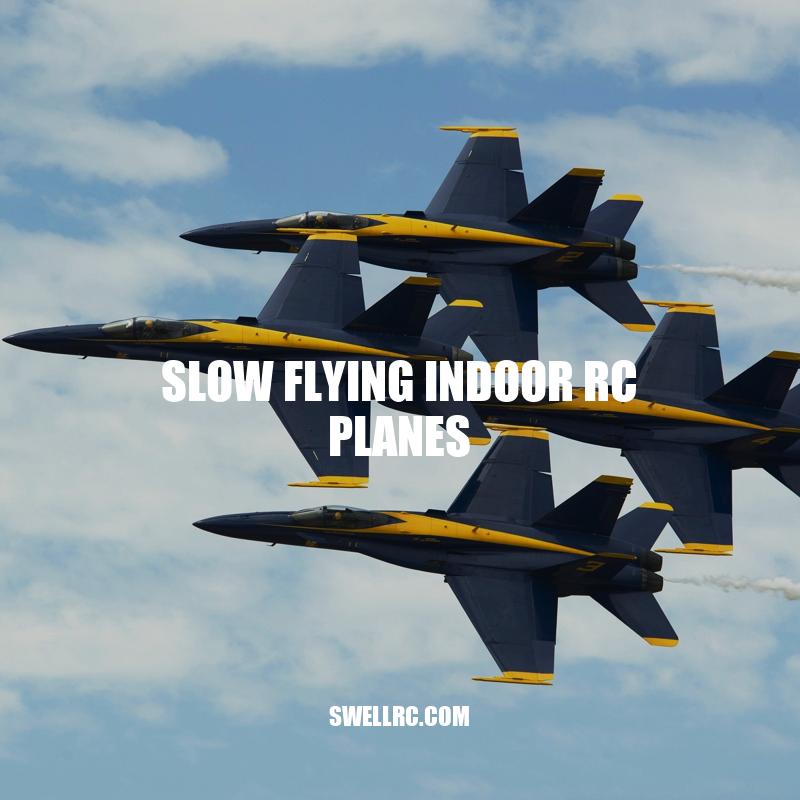Slow Flying Indoor RC Planes: A Guide to Fun and Easy Flying
Slow flying indoor RC planes have recently become a popular hobby for enthusiasts of all ages and skill levels. These planes are designed to fly at low speeds, making them ideal for indoor spaces such as gyms, living rooms, and even small offices. Compared to traditional RC planes, slow flying indoor planes are lightweight, smaller in size, and quieter in operation, providing a more peaceful and relaxing flying experience. The greater maneuverability of these planes also allows pilots to perform tricks and stunts in smaller spaces, adding an extra level of excitement to the hobby.
Slow flying indoor RC planes come in various types, including gliders, 3D planes, micro planes, and scale models. Gliders provide a smooth and continuous flight experience, making them great for beginners. 3D planes, on the other hand, allow pilots to perform acrobatic tricks and stunts such as loops and rolls, making them more suitable for intermediate and advanced pilots. Micro planes are extremely small and ideal for flying indoors in tight spaces, while scale models are designed to resemble real aircraft and provide a realistic flying experience. Depending on individual skill level and preferences, pilots can choose from a wide range of options to enjoy this hobby.
Advantages of Slow Flying Indoor RC Planes
Slow flying indoor RC planes offer numerous advantages over traditional RC planes. Some of these benefits include:
- Lightweight design for indoor areas
- Quieter and more peaceful flight experience
- Greater maneuverability in smaller spaces
- Lower risk of damage or injury compared to outdoor flying
These advantages make slow flying indoor RC planes an ideal hobby for those looking for a more relaxed and safe flying experience. In addition, manufacturers of these planes have created a wide range of models that provide unique features to enhance the flying experience. For example, some planes come equipped with gyroscopes for improved stability, while others have LED lights for flying in low-light conditions.
To further enjoy the hobby, pilots can join online forums and communities to connect with other enthusiasts and get tips and advice on flying. Websites such as rcgroups.com and rcuniverse.com offer a wealth of information on slow flying indoor RC planes, including product reviews, buying guides, and discussion forums. Additionally, retailers such as Horizon Hobby and Tower Hobbies offer a wide range of slow flying indoor RC planes for purchase, along with accessories and replacement parts to keep your plane in top condition.
What are the advantages of RC planes?
RC planes, or remote control planes, offer several advantages that make them a popular choice among hobbyists. Some of the advantages include:
- Ability to fly in a controlled environment: With an RC plane, you can fly it indoors or outdoors as per your preference and need.
- Improves Hand Eye Coordination: RC flying improves your hand-eye coordination and overall spatial awareness.
- Thrilling experience: RC planes can be flown and maneuvered in various ways, like steep drops and tight turns, which can give a thrilling experience.
- No License Needed: You don’t need a license to fly an RC plane. You can start with a beginner level plane and move up as you gain expertise.
RC planes are also available in different price ranges. You can find both low-cost and high-end RC planes from various websites and marketplaces like Amazon, HobbyKing, and Tower Hobbies. These websites offer a wide range of planes, including beginner-friendly planes and advanced ones.
Types of Slow Flying Indoor RC Planes
There are numerous types of slow flying indoor RC planes available on the market. Here are some of the most popular types:
- Gliders for smooth, continuous flight
- 3D planes for acrobatic tricks and stunts
- Micro planes for ultra-small spaces
- Scale models for realistic designs
Each type of plane offers its own unique flying experience and requires different skills to master. For example, gliders rely on thermal currents to stay in the air, while 3D planes require precise control of the plane’s range of motion. Additionally, micro planes are typically designed for indoor spaces less than 400 square feet in size, making them ideal for flying in small rooms or garages.
For those looking to invest in a slow flying indoor RC plane, it’s important to consider factors such as skill level, desired features, and budget range. Retailers such as Horizon Hobby and Tower Hobbies offer a wide variety of planes to choose from, along with customer reviews and ratings to help you make an informed decision.
For reference, here is a table that shows the specifications of some popular slow flying indoor RC planes:
| Plane Model | Wingspan (inches) | Weight (ounces) | Price |
| E-flite UMX Radian | 28.7 | 1.5 | $89.99 |
| ParkZone Ultra Micro P-51 Mustang | 15.9 | 1.7 | $149.99 |
| Blade Nano QX 3D | 14.1 | 1.1 | $59.99 |
What are the different types of RC planes?
RC planes can vary in design, size and capabilities. Here are some of the different types of RC planes available:
| Type | Description |
|---|---|
| Trainers | Designed for beginners, with stable flight characteristics and usually made of foam to withstand crashes. |
| Scale | Modeled after real-life planes, with intricate details and often larger sizes. |
| Aerobatic | Designed for acrobatic maneuvers and high-performance flying, with a light frame and powerful motor. |
| Gliders | No engine or motor, relying on wind currents for lift and flight. |
| FPV | First-person view planes equipped with a camera and video transmission system, allowing the pilot to fly from a distance and see what the plane “sees”. |
If you’re interested in purchasing an RC plane, websites such as Horizon Hobby (https://www.horizonhobby.com/) and Tower Hobbies (https://www.towerhobbies.com/) offer a variety of options for different types of planes.
Choosing the Right Slow Flying Indoor RC Plane
When choosing a slow flying indoor RC plane, there are several factors to consider. Here are a few tips to help you select the best plane for your needs:
- Assess your skill level: If you’re a beginner pilot, consider a glider or a micro plane, which are generally easier to fly than 3D planes.
- Focus on features: Think about the type of flying experience you want. If you want to perform tricks and stunts, 3D planes are the way to go. If you want a more relaxed flying experience, a glider may be the best option.
- Determine your budget: Slow flying indoor RC planes can range from less than $50 to more than $200. Decide on a budget before you start shopping to avoid overspending.
- Read reviews: Online retailers such as Amazon and HobbyKing offer customer reviews and ratings that can provide valuable insights into a plane’s performance and ease of use.
- Consider upgrading: Some slow flying indoor RC planes can be upgraded with new motors, batteries, and other components to improve their performance over time.
It’s also worth noting that some retailers offer bundled packages that include everything you need to get started, such as the plane, a controller, and batteries. This can be a convenient option for beginners who don’t have any existing equipment.
Ultimately, the right slow flying indoor RC plane depends on your individual needs and preferences. Take the time to research and compare different options to find the one that’s right for you.
How do I choose the right motor for my RC plane?
Choosing the right motor for your RC plane is crucial, as it directly affects the performance. Here are some factors to consider:
- Size and weight of the plane
- Propeller size
- Desired speed and power
- Battery voltage and capacity
To determine the correct motor size and KV rating, you can use online motor calculators such as eCalc or Motocalc. These tools can help you choose the right motor based on your desired specifications.
It’s important to choose a reputable and reliable brand, such as EMAX, T-Motor, or Hobbywing. You can find these brands and more at online stores such as HobbyKing or GetFPV.
To ensure the longevity of your motor, proper maintenance and care are essential. This includes keeping the motor clean and cool, avoiding overloading or overheating the motor, and checking for any signs of wear or damage.
Overall, choosing the right motor for your RC plane requires careful consideration of several factors. Utilizing online tools and selecting quality products from reputable brands can help ensure optimal performance and longevity of your motor.
Learning to Fly Slow Flying Indoor RC Planes
Learning to fly a slow flying indoor RC plane can be a fun and rewarding experience. Here are some basic tips to get you started:
- Start with a smaller space: When you’re first learning to fly, it’s best to start in a smaller space, such as a living room or garage. This will help you avoid collisions with walls and other obstacles.
- Practice takeoff and landing: Before attempting any tricks or maneuvers, practice takeoff and landing in a safe area. Make sure the plane is properly balanced and that you have enough space to maneuver.
- Master basic controls: Slow flying indoor RC planes have basic controls such as throttle, rudder, elevator, and ailerons. Practice using each of these controls until you feel comfortable with them.
- Avoid overcompensating: When trying to correct the plane’s direction or altitude, be careful not to overcompensate. Small adjustments are usually all that’s needed to keep the plane on course.
- Take breaks: Learning to fly a slow flying indoor RC plane can be tiring, both mentally and physically. Take regular breaks to avoid fatigue and frustration.
There are also many online resources available that can help you improve your flying skills. YouTube is a great place to find tutorial videos and reviews of different planes. You can also join online forums dedicated to RC flying to get advice and tips from other pilots.
If you’re looking for a more structured approach to learning to fly, there are many flight schools and training programs available as well. Some websites, such as RC Flight Academy, offer online training courses that teach everything from beginner skills to advanced aerial maneuvers.
By following these tips and utilizing online resources, you can quickly become a skilled pilot of slow flying indoor RC planes.
How do you learn to fly an RC plane?
To learn how to fly an RC plane, there are a few options:
1. Join a local RC flying club. They often have experienced pilots who can teach you the basics and offer tips and advice.
2. Purchase an RC flight simulator software program. This is a great way to learn in a safe and controlled environment.
3. Watch video tutorials on YouTube or other online platforms. Look for tutorials that cover the basics such as takeoff, landing, and maneuvering.
4. Attend an RC plane training course. Some hobby shops or RC plane manufacturers offer hands-on training courses.
Remember that practice makes perfect, so be patient and persistent in your learning process. Happy flying!
Website:
– Horizon Hobby has a collection of RC Flight Simulator to purchase and learn how to fly an RC plane.
| Option | Description |
|---|---|
| Join a local RC flying club | Experienced pilots can teach you the basics and offer tips and advice. |
| Purchase an RC flight simulator software program | A safe and controlled environment to learn how to fly an RC plane. |
| Watch video tutorials online | YouTube and other online platforms offer tutorials that cover the basics such as takeoff, landing, and maneuvering. |
| Attend an RC plane training course | Some hobby shops or RC plane manufacturers offer hands-on training courses. |
Maintenance and Upkeep of Slow Flying Indoor RC Planes
Proper maintenance of your slow flying indoor RC plane can ensure it lasts for a long time and performs optimally. Here are some tips:
- Inspect the plane before and after each flight: Carefully inspect the plane before and after each flight for any signs of damage or wear and tear.
- Clean the plane regularly: Use a soft cloth or brush to clean the plane after each flight. Make sure to clean the motor and propellers to prevent any build-up of debris.
- Store the plane properly: Make sure to store the plane in a safe space, away from any potential damage or hazards. Ideally, store it in a case or box to protect it from dust and debris.
- Charge batteries correctly: Follow the manufacturer’s instructions for charging the batteries. Overcharging or undercharging can both cause damage to the battery and affect its performance.
- Perform regular maintenance: Depending on the type of plane, you may need to perform regular maintenance such as lubricating gears or replacing worn-out parts. Check the manufacturer’s instructions or consult online resources for more information on proper maintenance.
If you’re not comfortable performing maintenance on your own, there are many professional RC repair services available. These services can often diagnose and fix any issues with your plane, as well as perform regular maintenance tasks such as replacing worn-out parts.
There are also many online resources available for purchasing parts or upgrades for your slow flying indoor RC plane. Websites such as HobbyKing and Tower Hobbies offer a wide variety of parts and accessories for all types of RC planes.
By following these maintenance tips and utilizing professional repair services or online resources, you can keep your slow flying indoor RC plane in top condition for many flights to come.
How long can a RC plane last?
The lifespan of a RC plane can vary depending on several factors, such as maintenance, usage frequency, and the quality of the materials used to build the plane. Generally, a well-maintained RC plane can last anywhere from several months to multiple years. Here are some factors that can affect the lifespan of an RC plane:
- Crashes and collisions, which can damage or break the plane.
- Battery life, as batteries have a limited number of charge cycles before they need to be replaced.
- Wear and tear over time, such as parts becoming loose or worn down from frequent use.
- The quality of the materials used to build the plane, as higher quality materials tend to be more durable and longer-lasting.
If you’re interested in purchasing an RC plane or looking for more information on the subject, websites such as rcuniverse.com and rcpowers.com offer a variety of resources and products for RC enthusiasts.
Conclusion
In conclusion, slow flying indoor RC planes offer a unique and enjoyable hobby for all ages and skill levels. These planes are designed for indoor flight, making them quiet and peaceful, with greater maneuverability in small spaces. With various types of planes to choose from and considerations for choosing the right one, here are some key takeaways:
– Gliders provide smooth, continuous flight, while 3D planes offer acrobatic potential and micro planes are ultra-small.
– Factors for choosing a plane include skill level and desired features, and considering budget and value for money.
– Learning to fly these planes requires basic skills and tips for avoiding common mistakes while improving your skills through time.
– Maintaining your slow flying indoor RC plane will ensure it lasts for many flights to come, and many online resources are available to purchase parts and accessories.
Overall, slow flying indoor RC planes offer a fun and immersive hobby that can be enjoyed alone or in a group setting. With constant advancements and improvements in the technology and design of these planes, there’s never been a better time to get started in this exciting hobby!



